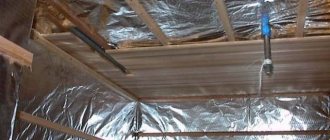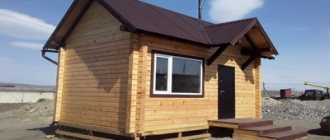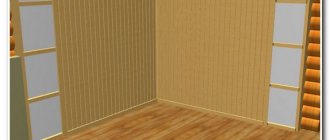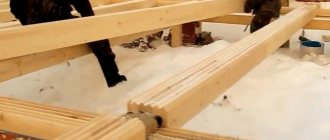When choosing the thickness of timber for the walls of a bathhouse, you can focus on several criteria, for example, the climate in the region, the presence of insulation, and others. The available budget for construction is also important. Maybe the bathhouse will not be used in winter, which often happens in the case of dachas. It would also be a good idea to take advantage of the experience of other people who have already built a timber bathhouse and used it for at least one full year.
If you don’t want to bother, and you need some kind of average solution to the problem, then you can resort to the standard, time-tested option. If the beam is profiled, with a cross-section of 150 mm, then this option will be the best for the money, and you will not freeze in the bathhouse, even if it is frosty outside -30°C.
If the average option is not for you, it’s worth spending two minutes of time and considering all the criteria described below for choosing the thickness of a beam for a bathhouse.
Generally accepted standards
Today, in the vast majority of cases, timber with a thickness of 90 mm to 200 mm is used for the construction of baths. The spread is considerable, and it is especially acute in terms of the price of lumber. For example, a 6x8 m bathhouse made of timber with a cross-section of 90 mm will cost about 500 thousand rubles (spacious, with an attic, bedrooms, a balcony and other amenities). If for its construction we take timber 200 mm thick, then approximately another 100 thousand rubles will be added to the indicated amount.
Naturally, the larger the cross-section of the walls, the warmer it will be inside. However, if you additionally insulate walls from relatively thin timber, then, in general, the costs will be slightly lower than if you achieve high thermal insulation characteristics by increasing the thickness of the timber. It is also worth considering that a bathhouse made from 200 mm timber is much heavier than one made from 90 mm timber. And this will require strengthening the foundation, which is not cheap.
What else is important to consider when choosing timber sizes?
Profiled and laminated timber differ in production technology. The first is made from solid logs and is not heat treated, so it is prone to shrinkage. It is better to take this fact into account and select a timber that is a little thicker, so that during final shrinkage it acquires the geometric dimensions that you expected. Glued laminated timber consists of lamellas and undergoes heat treatment at the production stage, subsequently practically not decreasing in size.
There is no point in choosing a thick beam if the bathhouse will be used only in the summer. Consider the use of thermal insulation and if you are going to seriously insulate the walls, then choose a material with a smaller cross-section.
Not many standard sections of timber are used in construction - the minimum width and thickness are 50 and 130 mm, and the maximum is 250x250mm. Ordering non-standard sections increases the cost of the material and is unprofitable when building a bathhouse.
Choosing the optimal cross-section of timber saves money on construction and makes it possible to build a bathhouse as warm as possible. Therefore, the choice of sizes must be approached responsibly.
Type of timber
If you use the most common timber today - profiled timber, then its thickness can be calculated to a minimum. Since the crowns are connected to each other using the tongue-and-groove system, the overall thermal insulation properties of the log house are increased when compared with planed timber.
The moisture content of lumber has no effect on the choice of its cross-section, contrary to popular opinions. So, even if a 150-mm profiled timber is kiln-dried or atmospheric-drying, there is absolutely no difference for the thermal insulation properties.
Options for design solutions for bath walls
Kiln-drying profiled timber is a modern technological material manufactured using high-precision, program-controlled equipment. Its aesthetic characteristics, the natural beauty of the texture of natural wood, as well as the absolute geometric accuracy of the forms are such that no additional finishing is required.
On the other hand, if the building is operated in conditions with long winters, severe frosts down to -30 degrees, you cannot do without insulation, and therefore without interior decoration. This is a good reason to save on building materials by choosing timber with a smaller cross-section thickness. The total thickness of the walls is calculated in this case, taking into account the thermal insulation parameters of the insulation and finishing.
You can also cut your budget by using timber with natural moisture, not forgetting that it will take a long time for the building to shrink. The price of lumber is also influenced by the type of wood; when calculating the thickness of the wall, it is necessary to take into account the degree of thermal conductivity of a particular tree.
The general conclusion is that the walls of the bathhouse will be thicker the further north the region of operation, the greater the height of the structure, and the worse the thermal conductivity parameters of the wood. But it is important to calculate this decisive parameter of the steam room design carefully and scrupulously in order to use the steam room comfortably at any time of the year.
Climate
You need to navigate this criterion based on the lowest air temperature in the region. Many people make the mistake of looking at the peak temperature, which lasts for only a few hours per year. It is more rational and correct to take the most severe frosts, which last for at least five days. This will allow you to save a lot, since you won’t have to “thicken” the walls in order to “not freeze” on the very day when the frost outside is at its peak. On this day you don’t have to take a steam bath.
Usually, if no additional insulation of the walls is provided, and the most severe frosts (prolonged) in the region reach -30°C, then for the construction of a warm bath a profiled beam with a cross-section of 150 mm is sufficient. If the conditions are different, you can focus on the specified starting point, not forgetting about the other criteria described below.
Why calculate the beam cross-section correctly?
The thickness and length of the timber must be optimal. A product that is too thin does not retain heat well and is not suitable for a bath. It is uncomfortable to be in a semi-cold bathhouse; the point of visiting the steam room is lost. And spending too much fuel on heating is not economically profitable.
If you choose too thick timber, problems with a lack of heat will not worry you, but in this case you are overpaying for the material. At the same time, there is practically no gain in heat preservation compared to the optimal option. To find the golden mean, the thickness of the log is calculated. The length of the timber also matters in financial savings - too many scraps, which are used only for firewood, seriously increase costs.
Availability of additional insulation
You can make a warm bathhouse from the most inexpensive profiled timber with a cross-section of 90 mm. To do this, simply insulate the walls. Outside, as a rule, a so-called ventilated façade with mineral wool up to 100 mm is installed. If this is not enough, then you can insulate the building from the inside, using the same mineral wool, but no more than 50 mm thick.
Insulation of the floor and interfloor ceilings should be by default, regardless of what kind of timber is used and whether the walls are insulated.
Regarding the experiences of real people. In fact, almost all of the above is the very experience of people who have had a bathhouse made of profiled timber for more than one season.
Comparison of materials
There are many materials that can be used to build a bathhouse. You need to evaluate the advantages and disadvantages of each option.
Beam or log
The joints between the logs must be caulked with felt or tow.
The log is a traditional material for the Russian bath. Such wood fully retains the advantages of the material: the highest heat conservation, the ability to regulate the microclimate by removing moisture out, exceptional durability and beauty.
However, the log shrinks greatly: the bathhouse can be finished and glazed no earlier than 1 year after construction. And after that, she sits down a little every year. Laying the log is very difficult. This requires high qualifications and experience. Periodically, the walls of the bathhouse need to be caulked.
A log building is inferior to a log house in terms of durability and comfort, but is erected much faster. Many builders believe that it is easier to insulate a building from timber than to build it from logs.
Timber or brick
It is difficult to compare these materials because they have different properties. In general, brick and stone are not the best option for a bathhouse, since brick is much heavier, has low vapor permeability and retains heat much worse.
But if a bath complex with guest rooms and a swimming pool is being built, brick may be the best solution.
Beam or blocks
A bathhouse made of blocks can be built faster and cheaper.
Cellular concrete is the most budget option for construction. The blocks are much larger than ordinary bricks, the building is built much faster, the surface of most foam concrete is smooth, which allows the stone to be joined very tightly. Their thermal conductivity is much lower than that of ordinary concrete.
The disadvantage of cellular concrete is hygroscopicity. It is less for non-autoclaved foam concrete, for example, and more for aerated concrete. Nevertheless, such walls need to be carefully waterproofed and finished both inside and outside. As a result, construction becomes more complicated, although it is cheaper than construction from laminated veneer lumber.
What kind of wood to choose for a bathhouse?
When choosing wood for building a bathhouse, you need to be especially scrupulous and attentive, because the steam room and washing compartments are rooms that can be described by two characteristics: high temperature and humidity. The wood in them goes through severe strength tests, so it must be durable and reliable.
There are 4 trees that are popular when choosing timber for the construction of a bathhouse:
- Cedar
This tree has a fairly high value due to its special properties: when the temperature rises, it releases essential oils into the air, which have a beneficial effect on human health, especially on the respiratory tract. Cedar timber is not susceptible to the negative effects of steam and water, which makes it an ideal option for building a bathhouse.
- Oak
Oak is also highly expensive, but its properties are also excellent for baths. Oak logs are very durable; they do not deform or crack from the constant influence of water and hot steam.
- Larch
Larch timber is the most common material for building a bathhouse due to its price/quality ratio. This tree is not subject to rotting from exposure to the environment in the steam room, and under the influence of water, larch timber, on the contrary, becomes even denser.
- Pine
Pine is the most budget-friendly of the proposed options. It is also quite resistant to high temperatures and water, but requires special processing. This tree contains resins that protect it from rotting and destruction, but because of them, the inside of the bathhouse must be treated with other wood. The resins released can burn the skin and respiratory tract.
Recommendations for insulating a bath
It is recommended to insulate the external walls of the steam room. Mineral wool, polystyrene foam, and EPS have a thermal conductivity of about 0.05. According to the calculation formula, 50 millimeters of insulation replaces 150 millimeters of a wooden wall. An example of calculating the thickness of a beam taking into account insulation:
- the combined use of a wooden wall 140 and insulation 100 will be equivalent to a wall 440, which practically coincides with the standards;
- the use of timber with a width of 190, insulation 50 can be equated to a wall with a thickness of 340 (all dimensions in millimeters).
Before construction, it is necessary to calculate the thickness of the timber based on the terrain and operating conditions.
Video description
This video shows how to calculate the amount of timber for a bathhouse:
Now let's multiply the required number of beams by the cubic capacity of 1 piece. The resulting number is 8.84 m³. This is exactly the number of cubes needed for a 6x4 bath.
Important! To help clients calculate how many cubes of timber are needed for a 6x4, 3x4 or 3x3 bathhouse, house-building companies equip their websites with calculators. This is the simplest calculation option.
But not everyone needs large areas. When financial possibilities are limited or there is little space on the land plot, a standard size is chosen. To determine how many cubes of timber are needed for a 3x4 bathhouse with a height of 2m, you need to do exactly the same calculations using formulas, but with different numbers. The final number will be 6-7 m³ - depending on the number of partitions. Provided that the cross-section is 15x15cm.
Frame bath: features
Concept
Frame technology for building baths in our country is considered know-how, but in other countries it has been used for centuries. Its essence is the construction of a frame - a post-and-beam structure from high-strength materials and filling the walls with inexpensive but high-quality raw materials.
The technology for constructing walls is as follows: assembling and installing the frame on a finished base - the foundation, laying insulation into the frame, installing steam and waterproofing, cladding the frame both from the inside and from the outside.
Frame baths are in enormous demand in Finland, Germany, the USA and Scandinavia. But recently, they are well winning their place in the sun in our country.
Advantages and disadvantages
Structures erected using frame technology, of course, have advantages and disadvantages. First, let's examine the undeniable advantages.
- Durability. Frame structures are durable and reliable, and therefore have a long service life.
- Environmental friendliness. Baths are built from environmentally friendly raw materials.
- Safety. Frame structures do not harm human health.
- Aesthetics. The designs are attractive.
- Ergonomics. The steam rooms are comfortable.
- Economical. The construction of a bathhouse will cost approximately 5,000 rubles per square meter.
- Speed of construction. The steam room has been under construction for about a month. But a good professional construction company will do its job much faster.
- Lightweight design. The frame is known for its low weight, so it is installed on a lightweight foundation.
- Seismic resistance. The structure can withstand vibrations of up to 5 points.
- All-season. The steam room is built not only in summer, but also in winter, but at a temperature not lower than -15°C (not comfortable to work).
- Non-shrinkability. The structure is not subject to shrinkage, which is why facing work is carried out immediately after the construction of the facility.
- Versatility. The surface of the bath goes well with any finishing raw material.
Now let's deal with the negative aspects.
- Money spendings. The construction of a bathhouse using frame technology is inexpensive, but insulation and finishing require large financial investments.
- Harm. As a rule, the frame for baths is made of wood, and it is, of course, absolutely safe, but the insulation, especially the cheap one, may contain harmful substances that become very “toxic” when heated, for example, polystyrene foam.
- Deterioration of performance characteristics in the cold season. Frame baths heat up quickly, but also cool down at lightning speed.
In principle, if you choose high-quality insulation and stock up on a lot of firewood, then a frame bathhouse is a pretty good option. And reviews from steam room owners are positive.
Interior decoration of the bath
The choice of building material largely depends on its availability. If the inner lining is made of wood, then it will retain heat in the steam room. Another option for long-term maintenance of the desired temperature in the steam room is internal thermal insulation of the walls. It will prevent heated air from escaping from the room. The result of internal lining of bathhouse walls with thermal insulation materials is the possibility of saving on the purchase of timber. With high-quality thermal insulation, it will be possible to purchase timber of smaller thickness. At the same time, the heating of the premises will be rapid, and the heat in them will remain longer.
Comparative characteristics of two types of baths
So, which one is better to make a bathhouse? Frame or timber? What to choose? Maybe the one that is more beautiful? Or the one that is more reliable? Or perhaps the one that is warmer? Stop! Which one is warmer, more beautiful or more reliable? Don't panic! Dear friends, to make your choice easier, I present to your attention a comparative description of two types of baths.
| Indicators | Frame bath | Timber bath |
| Aesthetics | 4 | 5 |
| Environmental friendliness | 4 | 5 |
| Safety | 4 | 5 |
| Thermal insulation properties | 1 | 5 |
| Warm-up speed | 4 | 5 |
| Heat retention | 2 | 5 |
| Finishing | 1 | 5 |
| Economical | 5 | 2 |
| Installation speed | 5 | 2 |
| Easy to install | 5 | 3 |
| Shrinkage | 5 | 4 |
| Resistance to environmental factors | 4 | 4 |
| Healing | 1 | 5 |
| Durability | 4 | 5 |
| Ergonomics | 5 | 5 |
*1, 2, 3, 4, 5 – ratings.
I think now you will make the right choice! Each type of bathhouse is good in its own way. But which steam room is better? Unfortunately, I cannot answer this question, since you need to focus on your financial capabilities and taste preferences. But as you know, there are no comrades for taste and color...
Good choice, dear readers! And bye, bye!!!
Wisdom Quote: Everyone wants to be informed honestly, impartially, truthfully - and in full accordance with his views (Chesterton Gilbert).
Wood type
In addition to the question of which beam to choose for a bath, you need to pay attention to the type of wood:
- oak is a moisture-resistant, aesthetic, high-quality, but expensive material;
- larch has high environmental qualities, strength, and reliability;
- linden is one of the most common materials for building baths, has a number of useful properties and does not require additional processing;
- spruce or pine - often used for subfloors and walls, sometimes used for cladding; the material is durable, but toxic, since conifers contain a high amount of essential oils and resins.
SNiP standards
To calculate the required beam width, the following factors must be taken into account:
- construction region (negative temperatures in winter);
- number of storeys of the building, its geometry;
- use in winter;
- additional insulation.
According to SNiP (building codes and regulations), a simplified formula for calculating the thickness of enclosing structures is the product of the heat transfer resistance coefficient and the thermal conductivity of wood. The main material for building a wooden bathhouse is pine or spruce; for calculations it is customary to take the average value of thermal conductivity at normal humidity levels of 0.15. The heat transfer resistance coefficient is different for different climatic regions. For Moscow and the Moscow region, a value of 3 is used. Substituting the required values in the formula, we obtain a wood width value of 45 centimeters. It is almost impossible to implement this in practice; trees of such thickness are very rare. Since the bathhouse does not involve living in it, it is not necessary to apply standards for residential premises.











